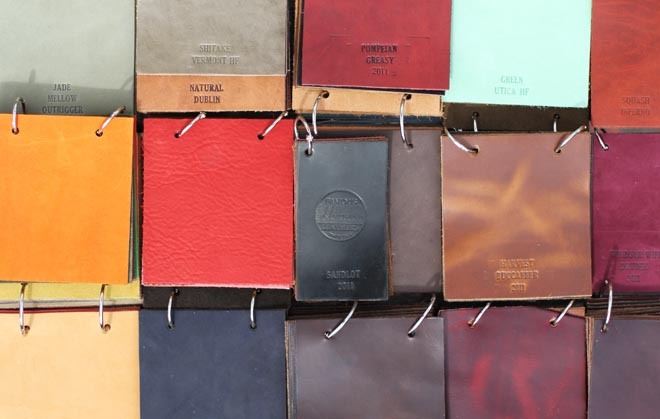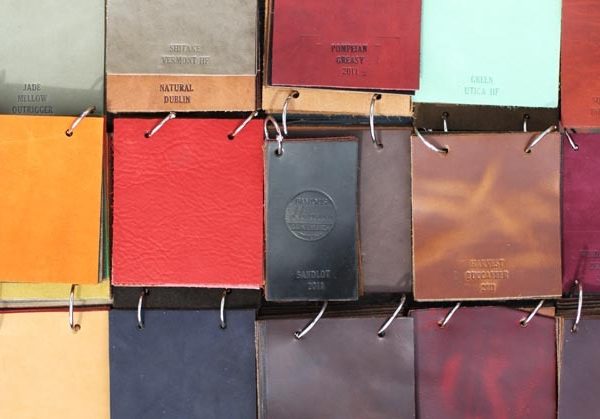
I recently had the good fortune of talking to Dave Munson and Frank Clegg – the two men behind Saddleback Leathers and Frank Clegg Leatherworks, respectively – about how to discern quality in leather goods. While many men at this point know how to judge the quality of suits, shoes, and even sweaters, few know how to tell if a bag or wallet is well made. So, given Dave and Frank’s expertise in the field, I thought I’d ask them for their thoughts.
This short-series will be covered in two articles. For today, we’ll talk about how to examine the quality of leather itself.
The Basics of Leather
Obviously, at its foundation, the quality of any leather good should be judged on the quality of the leather itself. As many already know, you should always shoot for full-grain leather, ideally one free of scars, blemishes, or fat deposits. Lotuff Leather has a good primer on how to look for these things.
Other types of leather include top and split grains. These are made by splitting a piece of leather into two layers. The top (top-grain) is typically sanded down and finished with some kind of chemical processing. This is what we typically call corrected-grain leather, and while it’s cheaper, it also has a colder, more plastic-like feel, and results in less breathability. Over time, it will also age less well and you won’t get the nice patina that you would with full-grain leather.
Split grain is what’s left after the top-grain has been separated from the hide. This part is often made into suede or embossed with a print so that it looks like full-grain. Unlike true full-grain, however, it’s often thinner and not as durable.
Finally, we have bonded leather. This stuff is basically junk. Here, leftover scraps of leather are grounded with glue and then bonded together in a process similar to vinyl manufacture. It’s basically to full-grain leather what particleboards are to solid wood. It neither looks nice nor lasts well.
How Manufacturers Cheat
So you know that full-grain should be preferred to top and split grain, and certainly to bonded leather. But this isn’t enough, as manufacturers often cheat. How?
Well first, there are semantics. A manufacturer can say that something is made from “genuine leather” when it’s actually top or split grain, or even bonded leather. They’re not lying. It is made from genuine leather. The other way is to say that something is “made with full-grain leather” when only part of it is. Again, they’re not lying. A bag can be partly made with full grain leather, while something as cheap as vinyl is used for other parts.
The other way to cheat is by buying full-grain leather that hasn’t been processed fully. See, after a tannery removes the moisture, oils, and hair from an animal skin, they put it into giant drums with tanning solutions. These drums are expensive, however, and can cost upwards of $100,000. The tanning solutions they use can also be costly. To curb some of these expenses, some tanneries won’t let the hides sit in the drums as long as they need to. That way, they can process more hides using fewer drums and less tanning solution. In the end, the leather on your products can fade and crack with too much sunlight. You can tell whether something has been fully tanned by looking at the edges. Assuming it hasn’t been painted over with some type edge finishing, such leathers will appear blue in the middle, which shows that the tanning solution hasn’t been allowed to soak through all the way. You can see this in the write up that Dave published on his website.
When we spoke, I asked Dave whether such “half-tanned” leathers are really something you’d ever find on more expensive products. “All the time,” he said. “Not all of them, of course, but if the company they outsource to is not carefully watched or if it is something that the brand is not aware of, then they’ll be getting low quality leather that is hidden with rolled or painted edges to cover up the poorly tanned leather.” Dave also noted that this isn’t something you tell just from the outside grain. The leather feels the same, but the middle will dry out and crack. The only way to tell is by looking at the edge and seeing if the middle is blue, but this also assumes that the edge hasn’t already been covered.
Takeaways
In the end, if you’re buying a leather good, you should aim for full-grain leather, but also make sure that the tannage has soaked through all the way. You may also want to ask the manufacturer whether the product was fully made with full-grain leather, and examine the skin for defects such as scars, blemishes, and fat deposits. Of course, many products will have some kind of defect somewhere. Often this will be done in places where the consumer can’t see, such as the inside of a bag. This doesn’t automatically discount the quality of the good, necessarily, but it is something you may want to consider if you’re paying top-dollar for something.
Come back Monday, when I’ll talk about the quality of hardware that’s often used, as well as a bit about the construction of leather goods.
(Pictured above: Leather swatches from Horween, one of the best tanneries in the world. Photo taken from Carryology)








